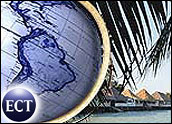
The U.S. government sold more than US$3.6 billion via e-commerce in 2000, topping the $2.8 billion in online sales seen by e-tail giant Amazon, according to a study released Sunday by the Pew Internet & American Life Project and Federal Computer Week.
“It is a natural evolution for the government to sell directly to the public,” said Bill Piatt, director of e-government strategy at Booz-Allen & Hamilton and former director of the U.S. General Services Administration (GSA).
“Many more citizens have access to property online than they do through the old approach,” Piatt said.
Some government sites sell directly to the public through their own sites, while others contract with private companies to run their e-tail activities. Some, like the U.S. Post Office, use online auction houses to sell surplus goods.
From Mustangs to Maps
According to the “Dot-gov Goes Retail” study, the items offered for sale online by the U.S. Government range from wild mustangs sold by the Bureau of Land Management to maps sold by the U.S. Geological Survey.
Other items offered for sale through government Web sites include used army trucks sold by the U.S. Department of Defense and houses sold through the GSA.
In addition, the U.S. Treasury site sells savings bonds and T-bills through its Web site.
Coins and Campers
One of the most successful government e-tailers is the United States Mint. In 2000, it rang up $150 million in sales of collectible and commemorative coins, holiday ornaments and jewelry, compared to the $41.4 million it sold during the eight months it was online in 1999.
Amtrak, the National Park Service, and the Foreign Broadcast Information Service are also bringing in big bucks through the online activities. Amtrak sold more than $62 million in tickets online last year, and campers made more than $5.4 million worth of online reservations through the National Park Service last year.
Meanwhile, the Foreign Broadcast Information Service sold $1 million in subscriptions for newspaper articles translated by the Central Intelligence Agency (CIA).
Buried Treasure
Although some government entities are embracing online sales and making it easy for consumers to buy online, others are making it difficult for consumers to find and purchase bargains.
For instance, the U.S. Library of Congress’ American Folklife Center sells recordings of 1940s blues music online, but the link is buried three layers deep at the Library of Congress site.
The site for presidential libraries, administered by the National Archives and Records Administration, also has a host of interesting items for sale on the Internet, including a reproduction of John F. Kennedy’s rocking chair. However, would-be buyers have to phone or fax in their orders.
Points of Entry
Consumers looking for government bargains often have to search through dozens of Web sites to find what they are looking for, because the federal government has not yet created an efficient search engine for government sales, the GSA said.
“Agencies haven’t seen the benefit of a single port of entry,” said Mary Mitchell, head of the GSA’s office of e-government. “For the most part, doing it right will cost money, and the agencies aren’t into spending money.”![]()















































Impressive 3.6 billion in sales! I’m wondering how much RED INK that put on the bottom line? Also curious what percentage was done by outside contractors and how much profit they generated. Are any of these points mentioned elsewhere in the report?